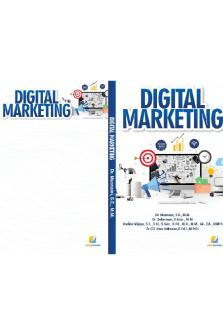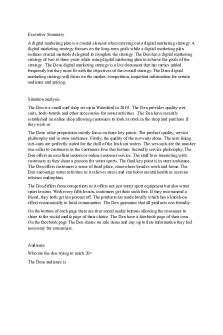Digital Marketing Chapter 2 NOTES PDF

| Title | Digital Marketing Chapter 2 NOTES |
|---|---|
| Course | Digital Marketing |
| Institution | University of Houston-Downtown |
| Pages | 7 |
| File Size | 241.9 KB |
| File Type | |
| Total Downloads | 22 |
| Total Views | 133 |
Summary
Digital Marketing Chapter 2 NOTES...
Description
MKT 3305 – Digital Marketing Chapter 2 - Notes
Chapter 2 – The Role of IMC in the Marketing Process Learning Objectives -
Describe the role of advertising and promotion in an organization’s integrated marketing program. Define target marketing. Discuss the role of market segmentation in an IMC program. Describe positioning and repositioning strategies. Identify the marketing-mix decisions that influence advertising and promotional strategy.
Figure 2-1 Marketing and Promotions Process Model
Marketing Strategy and Analysis •
Strategic marketing plan: – Guides allocation of organization’s resources – Guides specific marketing programs and policies 1
MKT 3305 – Digital Marketing Chapter 2 - Notes
– Evolves from an organization’s overall corporate strategy – Allows for an understanding of market opportunities, competition, and market segments •
Market segments: distinct consumer groups within a market who have common needs
Opportunity Analysis •
Market opportunities: Areas where: – There are favorable demand trends – Customers’ needs and opportunities are not being satisfied – Firm can compete effectively
•
Steps to identify market opportunities – Examine the marketplace – Observe demand trends and competition in various market segments
Competitive Analysis •
Analyzing the competition in the marketplace and searching for a competitive advantage – Competitive advantage: Attributes that give a firm an edge over competitors •
Better quality products
•
Superior customer service
•
Low production costs and lower prices
•
Dominating channels of distribution
•
Advertising
Target Market Selection •
Done after evaluating market opportunities and doing a competitive analysis
•
Has direct implications on a firm’s advertising and promotional efforts
Figure 2-2 The Target Marketing Process
Identifying markets with unfulfilled needs
Determining market segmentation
Selecting a target market
Positioning through marketing strategies
MKT 3305 – Digital Marketing Chapter 2 - Notes
Identifying Markets •
Marketer identifies the specific needs of groups of people (or segments)
•
Selects one or more of these segments as a target
•
Isolates consumers with similar lifestyles, needs, and the like
•
Increased marketer’s knowledge of consumers’ specific requirements
Market Segmentation
Dividing a market into distinct groups with common needs, who respond similarly to a marketing situation
Customer characteristics segmentation criteria
Geographic: Dividing the market on the basis of region, city size, metropolitan area, and/or density
Demographic: Dividing the market on the basis of age, sex, family size, marital status, etc.
Socioeconomic: Dividing the market on the basis of income, education, or occupation
Psychographic: Dividing the market on the basis of personality, lifecycles, and/or lifestyles
Buying Situations
Markets can also be divided by customer buying situations
Buying situations segmentation criteria
Outlet type
Benefits sought
Usage
Awareness and intentions
Behavior
Basis for Market Segmentation
Behavioristic segmentation 3
MKT 3305 – Digital Marketing Chapter 2 - Notes
Dividing consumers into groups according to their usage, loyalties, or buying responses to a product
80-20 rule: 20 percent of buyers account for 80 percent of sales volume
Benefit segmentation
Grouping of consumers on the basis of attributes sought in a product
Selecting Target Market
Determine how many segments to enter
Utilizing market coverage alternatives
Determine which segments offer the most potential
Selecting the most attractive segment
Market Coverage Alternatives •
Undifferentiated marketing •
•
Differentiated marketing •
•
Ignoring segment differences and offering just one product or service to the entire market
Involves marketing in a number of segments, developing separate marketing strategies for each
Concentrated marketing •
Selecting a segment and attempting to capture a large share of this market
Selecting the Most Attractive Segment
Sales potential of segment
Opportunities for growth
Competition analysis
Ability to compete
Ability to market to this group
Market Positioning
4
MKT 3305 – Digital Marketing Chapter 2 - Notes
•
Positioning: Fitting a product or service to one or more segments of the broad market to make it unique within the marketplace
•
Approaches – Focusing on the consumer—Linking the product with the benefits the consumer will derive – Focusing on competition—Positions the product by comparing the benefit it offers versus the competition
Positioning Strategies
Positioning by product attributes and benefits
Sets the brand apart from competitors on the basis of specific characteristics or benefits offered
Salient attributes: Important to consumers and are the basis for making a purchase decision
Positioning by price/quality
Done where cost comes secondary to quality
Positioning by use or application
Used to enter a market on the basis of a particular use or application
Positioning by product class
Positioning by product user
Positioning by competitor
Positioning by cultural symbols
Makes the brand easily identifiable and differentiated from others
Repositioning •
Altering a product’s or brand’s position due to: – Declining or stagnant sales – Anticipated opportunities in other market positions
5
MKT 3305 – Digital Marketing Chapter 2 - Notes
•
Difficult to accomplish because of entrenched perceptions and attitudes toward the product or brand
Product Decisions
Product symbolism: Refers to:
What a product or brand means to consumers
What consumers experience in purchasing and using a product
Branding
Building and maintaining a favorable identity of the company and its products
Packaging
Provides functional benefits such as economy, protection, and storage
Branding
Builds and maintains brand awareness and interest
Develops and enhances attitudes toward the company or product
Builds relationships between the consumer and the brand
Brand identity
Combination of name, logo, symbols, design, packaging, image, and associations held by consumers
Brand equity
Intangible asset of added value
Packaging
Traditionally, the package provided functional benefits: economy, protection, and storage
Role and function have changed due to:
Self-service emphases of many stores
More buying decisions at point of purchase
First impressions matter
Often first exposure to product
Price Decisions
6
MKT 3305 – Digital Marketing Chapter 2 - Notes
Price variable—Refers to what the consumer has to give in exchange for a purchase
Factors that determine price
Costs
Demand factors
Competition
Perceived value
Product quality
Advertising
Marketing Channels •
Interdependent organizations involved in making a product or service available for use
•
Direct channels: Directly deal with customers – Driven by direct-response ads, telemarketing, the Internet – Used when selling expensive and complex products
•
Indirect channels: Network of wholesalers and/or retailers
Promotional Push Strategies •
Programs designed to persuade the trade to stock, merchandise and promote a manufacturer’s products
•
Goal – Push the product through the channels of distribution by selling and promoting it
•
Trade advertising: Used to motivate wholesalers and retailers to purchase products for resale
•
Spending money on advertising and sales promotion efforts directed toward the ultimate consumer
•
Goals – Create demand among consumers – Encourage consumers to request the product from the retailer
7...
Similar Free PDFs

Marketing Digital Tema 2
- 6 Pages

Quiz Chapter 8 DIGITAL Marketing
- 1 Pages

Digital Marketing
- 10 Pages

DIGITAL MARKETING
- 127 Pages

MARKETING DIGITAL
- 15 Pages

Marketing digital - Notes de cours 1
- 29 Pages

BS3988 Digital Marketing
- 16 Pages

Digital marketing strategy Essay
- 7 Pages

The Digital Marketing Canvas
- 1 Pages

Digital Marketing - pdf
- 32 Pages

Origen del Marketing Digital
- 3 Pages

Digital marketing plan
- 1 Pages

Marketing chapter 1 notes
- 5 Pages
Popular Institutions
- Tinajero National High School - Annex
- Politeknik Caltex Riau
- Yokohama City University
- SGT University
- University of Al-Qadisiyah
- Divine Word College of Vigan
- Techniek College Rotterdam
- Universidade de Santiago
- Universiti Teknologi MARA Cawangan Johor Kampus Pasir Gudang
- Poltekkes Kemenkes Yogyakarta
- Baguio City National High School
- Colegio san marcos
- preparatoria uno
- Centro de Bachillerato Tecnológico Industrial y de Servicios No. 107
- Dalian Maritime University
- Quang Trung Secondary School
- Colegio Tecnológico en Informática
- Corporación Regional de Educación Superior
- Grupo CEDVA
- Dar Al Uloom University
- Centro de Estudios Preuniversitarios de la Universidad Nacional de Ingeniería
- 上智大学
- Aakash International School, Nuna Majara
- San Felipe Neri Catholic School
- Kang Chiao International School - New Taipei City
- Misamis Occidental National High School
- Institución Educativa Escuela Normal Juan Ladrilleros
- Kolehiyo ng Pantukan
- Batanes State College
- Instituto Continental
- Sekolah Menengah Kejuruan Kesehatan Kaltara (Tarakan)
- Colegio de La Inmaculada Concepcion - Cebu


